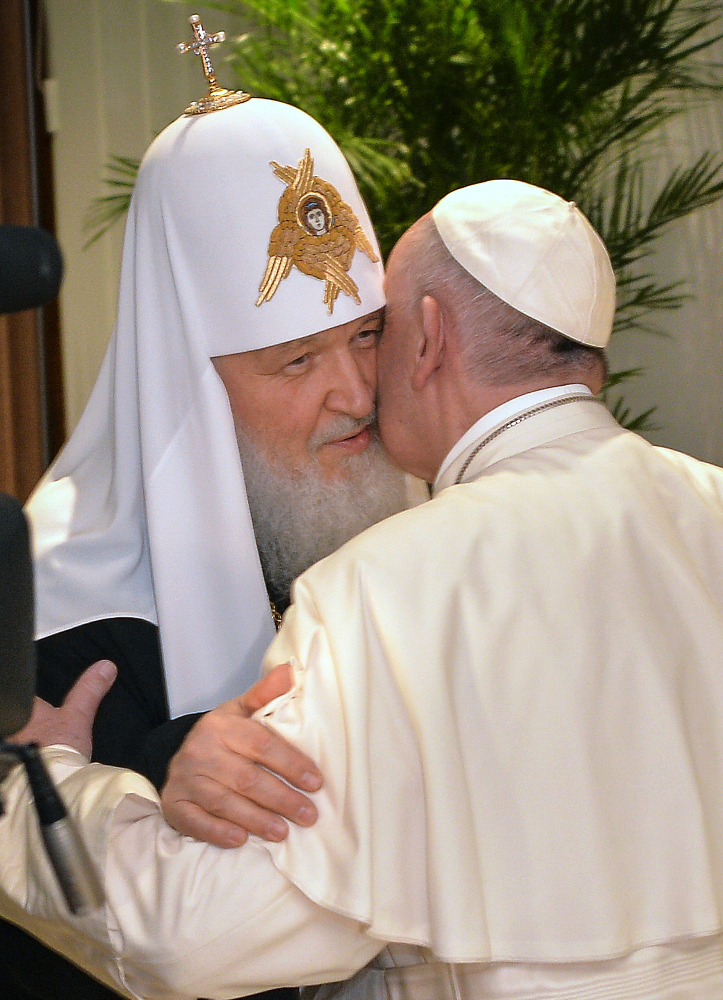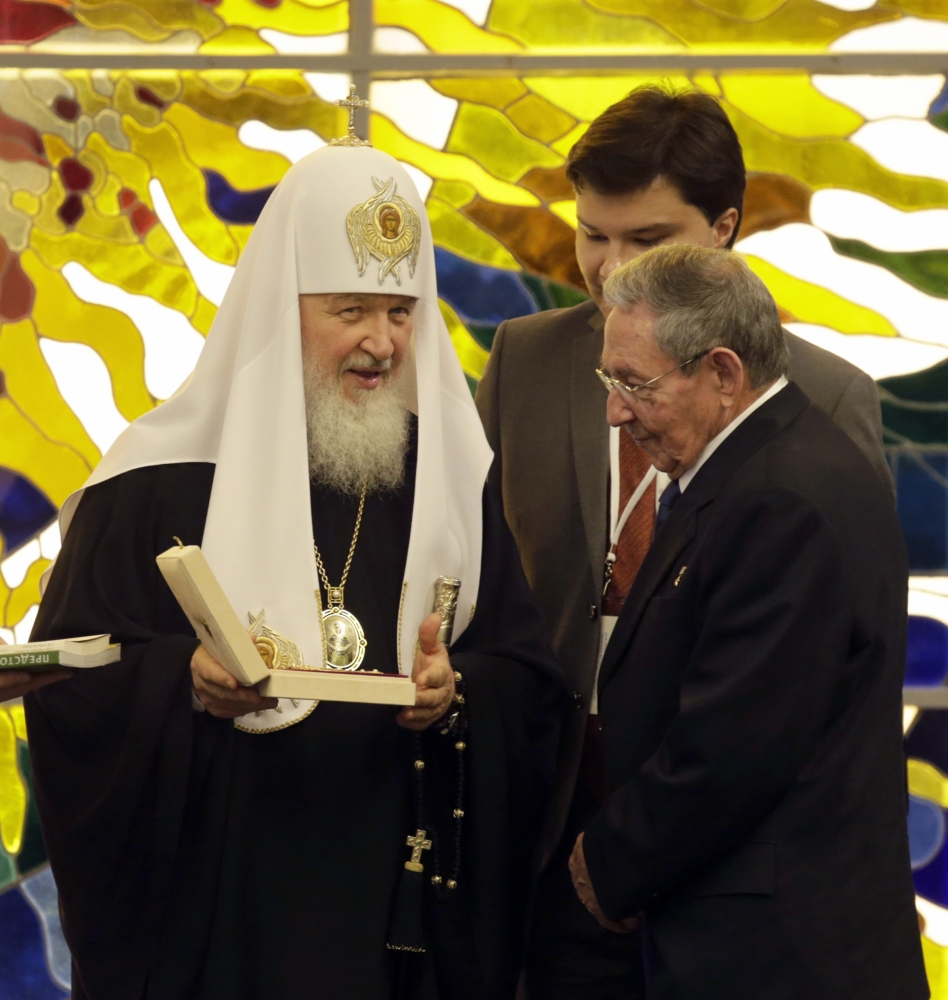HAVANA — With a hug and an exclamation of “Finally!” Pope Francis met Friday with Patriarch Kirill in the first ever meeting between a pontiff and the head of the Russian Orthodox Church, a historic development in the 1,000-year schism that has divided Christianity.
“We are brothers,” Francis said as he embraced Kirill in the small, wood-paneled VIP room of Havana’s airport, where the three-hour encounter took place.
“Now things are easier,” Kirill agreed as he and the pope exchanged three kisses on the cheek. “This is the will of God,” the pope said.
Francis was having the brief talks in Cuba before heading off on a five-day visit to Mexico, where the pontiff will bring a message of solidarity with the victims of drug violence, human trafficking and discrimination to some of that country’s most violent and poverty-stricken regions.
The meeting and signing of a joint declaration was decades in the making and cemented Francis’ reputation as a risk-taking statesman who values dialogue, bridge-building and rapprochement at almost any cost.
Still, while the meeting has been hailed by many as an important ecumenical breakthrough, Francis has also come under criticism for essentially allowing himself to be used by a Russia eager to assert itself among Orthodox Christians and on the world stage at a time when the country is increasingly isolated from the West.
The joint declaration is expected to touch on the single most important issue of shared concern between the Catholic and Orthodox churches today: the plight of Christians in Iraq and Syria who are being killed and driven from their homes by the Islamic State group.
It is being signed in the uniquely ideal location of Cuba: far removed from the Catholic-Orthodox turf battles in Europe, a country that is Catholic and familiar to Latin America’s first pope, but equally familiar to the Russian church given its anti-American and Soviet legacy.
SPIRITUAL ADVISER TO PUTIN
The Vatican is hoping the meeting will improve relations with other Orthodox churches and spur progress in dialogue over theological differences that have divided East from West ever since the Great Schism of 1054 split Christianity.
But Orthodox observers say Kirill’s willingness to finally meet with a pope has less to do with any new ecumenical impulse than grandstanding within the Orthodox Church at a time when Russia is increasingly under fire from the West over its military actions in Syria and Ukraine.
Kirill, a spiritual adviser to Russian President Vladimir Putin, leads the most powerful of the 14 independent Orthodox churches that will meet this summer in Greece in the first such pan-Orthodox synod in centuries.
“This isn’t benevolence. It’s not a newfound desire for Christian unity,” said George Demacopoulos, the Greek-Orthodox chairman of Orthodox Christian studies at Fordham University in New York. “It is almost entirely about (Kirill) posturing and trying to present himself as the leader of Orthodoxy.”
Popes as far back as Paul VI have met with the ecumenical patriarch in Istanbul, who is the “first among equals” in the 250 million-strong Orthodox Church and the only patriarch who can speak for global Orthodoxy. But the Russian church is the biggest, wealthiest and most powerful in Orthodoxy, and has always kept its distance from Rome.
TENSIONS FOR CENTURIES
Catholic and Orthodox split in the Great Schism of 1054 and have remained estranged over a host of issues, including the primacy of the pope and, more recently, Russian Orthodox accusations that the Catholic Church was poaching converts in former Soviet lands.
Those tensions have prevented previous popes from ever meeting with the Russian patriarch, even though the Vatican has long insisted that it was merely ministering to tiny Catholic communities.
The most vexing issue in recent times centers on the Ukrainian Greek Catholic Church, the country’s second-largest, which follows eastern church rites but answers to the Holy See.
The Russian Orthodox Church has considered western Ukraine its traditional territory and has resented papal influence there.
The Russian church has always been reluctant to engage in theological dialogue over the primacy of the pope, said the Rev. Stefano Caprio, one of the first priests who arrived in Russia in 1989 to minister to the Catholic community and now is a professor of Russian history and culture at the Pontifical Oriental Institute in Rome.
Caprio said the Russian position has long been: “We’re interested in ecumenism only in the sense of collaboration in managing the crises of a Christianity that is attacked in some countries by violent forces … and above all to unite against global secularization,” he said.
He noted, for example, that Friday’s meeting doesn’t include any joint prayer – purely talks. “It’s not an ecumenical encounter,” he said.
While a papal trip to Russia is still a long-sought dream, Caprio ruled it out for the foreseeable future.
“It would be a bigger scandal than Pussy Riot,” he said.
Immediately following his meeting with Kirill, the pontiff was to fly to Mexico for a weeklong tour that will take him once again to uncharted papal territory.
Among his stops will be the crime-plagued Mexico City suburb of Ecatepec, where his visit will shine an uncomfortable spotlight on the government’s failure to solve entrenched social ills that plague many parts of Mexico – inequality, rampant gangland killings, extortion, disappearances of women, crooked cops and failed city services.
He will also visit the mainly indigenous southern state of Chiapas, which has the country’s highest poverty rate. There he will celebrate a very Indian Mass and present a decree authorizing the use of indigenous languages in liturgy.
Francis will end his trip in the violent northern city of Ciudad Juarez, where he will pray at the border for all who have died trying to cross into the U.S. – a prayer he hopes will resonate north of the border.
Send questions/comments to the editors.




Success. Please wait for the page to reload. If the page does not reload within 5 seconds, please refresh the page.
Enter your email and password to access comments.
Hi, to comment on stories you must . This profile is in addition to your subscription and website login.
Already have a commenting profile? .
Invalid username/password.
Please check your email to confirm and complete your registration.
Only subscribers are eligible to post comments. Please subscribe or login first for digital access. Here’s why.
Use the form below to reset your password. When you've submitted your account email, we will send an email with a reset code.